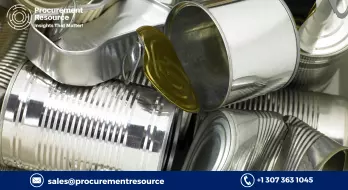Tin Demand Fuelled by Electronics and Low-Carbon Technology

This year, tin, frequently referred to as a forgotten important metal, has overtaken all other foundation metals in terms of price, smashing previous highs. According to Chantel Kotze, tin appears to have a good and stable future as a vital raw element in the technologies necessary for the Fourth Industrial Revolution and the transition to a net-zero carbon economy.
Check Real-Time Price Now: Tin Price
Tin cash prices on the London Metal Exchange (LME) rose to more than USD 37,000/t in early October, representing a 100 percent year-on-year increase. The surge in costs this year is mainly due to high demand and limited supply. The International Tin Association (ITA) predicted that refined tin usage would fall 1.6 percent to 361 900 t in 2020 in its 17th annual survey of tin clients, which will be released in October 2021. While the ITA forecasts a 7.2 percent increase in refined tin use in 2021 because of the COVID-19 epidemic's recovery, more recent data suggests that this projection may be too optimistic, as supply issues have impeded tin consumers in the second quarter of the year. According to ITA research, solder still accounts for the most significant global percentage of tin use, and however, this is predicted to reduce to 48 percent in 2020. However, due to the rapid rebound, ITA predictions for 2021 anticipate a global average increase of 8.8 percent.
Tin's principal application in solder is while manufacturing semiconductors, which accounts for nearly 80 percent of solder usage. According to the ITA, increased working, learning, and leisure from home in 2020 increased this utilisation, giving tin demand an unexpected boost during the year in question.
Solder demand is primarily measured by the sale of semiconductor chips, which are used to fabricate electrical devices ranging from vehicles to computers and appliances. According to numbers released in October 2021 by the Semiconductor Industry Association, worldwide semiconductor sales increased 29.7 percent year over year in August across all main product categories and in every primary regional market.
The International Tin Association (ITA) predicted that refined tin usage would fall 1.6 percent to 361 900 t in 2020 in its 17th annual survey of tin clients, which will be released in October 2021.
According to ITA research, solder still accounts for the largest global percentage of tin use. However, this is predicted to fall to 48 percent in 2020. However, due to the rapid rebound, ITA predictions for 2021 anticipate a global average increase of 8.8 percent. Pearce, who is interested in exploring future uses for tin, feels that solder, and energy technologies such as lithium-ion battery technology, hold most of the future potential for tin.
Energy and contemporary technology, such as computing and robotics; energy infrastructure, storage and generating technologies; and autonomous and electric cars are the most powerful new usage drivers, with tin solder serving as the glue that ties all electronic and electrical equipment together.
Despite an annual growth in electronics manufacture of between 4 percent and 5 percent, solder consumption has remained stable over the previous decade due to miniaturisation of electronics and electrical components," Pearce adds. The ITA, on the other hand, expects the miniaturisation trend to slow, resulting in higher solder consumption over the next decade, which will be more directly related to larger electronics production.
Tin is already benefiting from additions to lead-acid batteries and solder used to connect solar cells. Pearce believes tin has many future applications in lithium-ion and other batteries, solar photovoltaic technology, thermal materials, hydrogen-related applications, and carbon capture catalysis. For the foreseeable future, ITA market analyst James Willoughby predicts that China and Indonesia will continue to be the world's largest producers of tin - both mined and processed. On the other hand, new mining projects are mostly concentrated in Africa, Europe, and Australia, which are predicted to have the largest growth over the next decade.
Pearce, who curates 1,500 scientific research and development journals each month on average to anticipate future tin demand, says it's tough to forecast future tin demand based on how large of an impact future R&D use cases may have and how quickly that could happen. The ITA expects tin demand to increase over the next few years, up from its current long-term projection of 2 percent to around 3 percent to 4 percent.




